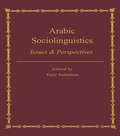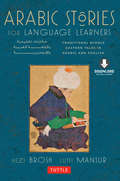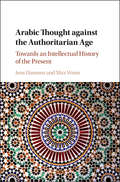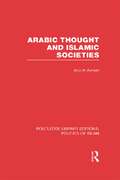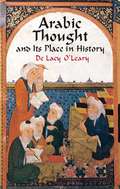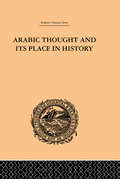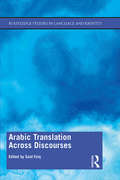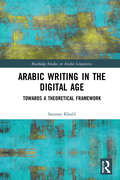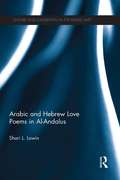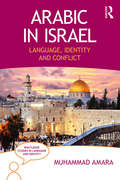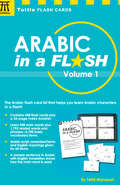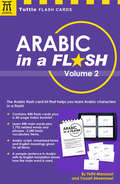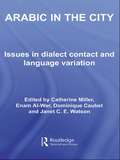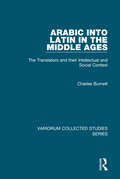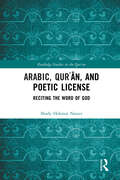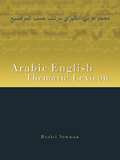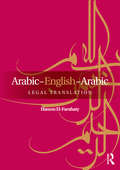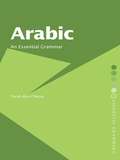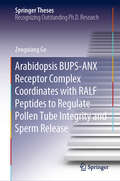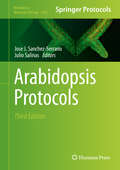- Table View
- List View
Arabic Sociolinguistics: Issues and Perspectives
by Yasir SuleimanA coherent and stimulating survey of current research.
Arabic Stories
by Hezi Brosh Lutfi MansurArabic Stories for Language Learners—a language learning experience for beginner to intermediate students. The traditional stories of a country are invaluable at providing insight into understanding the culture, history and language of a people. The sixty-six stories found in Arabic Stories for Language Learners present the vocabulary and grammar used everyday in Arabic-speaking countries. Pulled from a wide variety of sources that have been edited and simplified for learning purposes, these stories are presented in parallel Arabic and English, facilitating language learning in the classroom and via self-study. Each story is followed by a series of questions in Arabic and English to test comprehension and encourage discussion. Arabic Stories for Language Learners brings Arab culture to life in a colorful and immediate way. Regardless of whether or not you have a working knowledge of Arabic, this book gives readers a tantalizing introduction to the wisdom and humor of these ancient desert-dwelling peoples. An audio CD in Arabic and English helps students of Arabic improve their pronunciation and inflection, and immerses non-students into the uniquely Arabic storytelling style.
Arabic Stories for Language Learners
by Hezi Brosh Lutfi MansurArabic Stories for Language Learners--a language learning experience for beginner to intermediate students.The traditional stories of a country are invaluable at providing insight into understanding the culture, history and language of a people. The sixty-six stories found in Arabic Stories for Language Learners present the vocabulary and grammar used everyday in Arabic-speaking countries. Pulled from a wide variety of sources that have been edited and simplified for learning purposes, these stories are presented in parallel Arabic and English, facilitating language learning in the classroom and via self-study. Each story is followed by a series of questions in Arabic and English to test comprehension and encourage discussion.Arabic Stories for Language Learners brings Arab culture to life in a colorful and immediate way. Regardless of whether or not you have a working knowledge of Arabic, this book gives readers a tantalizing introduction to the wisdom and humor of these ancient desert-dwelling peoples. An audio CD in Arabic and English helps students of Arabic improve their pronunciation and inflection, and immerses non-students into the uniquely Arabic storytelling style.
Arabic Thought Beyond the Liberal Age
by Max Weiss Jens HanssenWhat is the relationship between thought and practice in the domains of language, literature and politics? Is thought the only standard by which to measure intellectual history? How did Arab intellectuals change and affect political, social, cultural and economic developments from the eighteenth to the twentieth centuries? This volume offers a fundamental overhaul and revival of modern Arab intellectual history. Using Hourani's Arabic Thought in the Liberal Age, 1798–1939 (Cambridge, 1962) as a starting point, it reassesses Arabic cultural production and political thought in the light of current scholarship and extends the analysis beyond Napoleon's invasion of Egypt and the outbreak of World War II. The chapters offer a mixture of broad-stroke history on the construction of 'the Muslim world', and the emergence of the rule of law and constitutionalism in the Ottoman empire, as well as case studies on individual Arab intellectuals that illuminate the transformation of modern Arabic thought.
Arabic Thought against the Authoritarian Age: Towards an Intellectual History of the Present
by Max Weiss Jens HanssenIn the wake of the Arab uprisings, the Middle East descended into a frenzy of political turmoil and unprecedented human tragedy which reinforced regrettable stereotypes about the moribund state of Arab intellectual and cultural life. This volume sheds important light on diverse facets of the post-war Arab world and its vibrant intellectual, literary and political history. Cutting-edge research is presented on such wide-ranging topics as poetry, intellectual history, political philosophy, and religious reform and cultural resilience all across the length and breadth of the Arab world, from Morocco to the Gulf States. This is an important statement of new directions in Middle East studies that challenges conventional thinking and has added relevance to the study of global intellectual history more broadly.
Arabic Thought and Islamic Societies (Routledge Library Editions: Politics of Islam)
by Aziz Al-AzmehThis is a study of the structure and composition of the official learning current in medieval Arabic culture. This comprises natural sciences both exoteric and esoteric (medicine, alchemy, astrology and others), traditional and religious sciences (such as theology, exegesis and grammar), philosophical sciences such as metaphysics and ethics, in addition to technical disciplines like political theory and medicine, and other fields of intellectual endeavour. The book identifies and develops a number of conceptual elements common to the various areas of official Arabic scientific discourse, and shows how these elements integrate these disparate sciences into an historical epistemic unity. The specific profile of each of these different sciences is described, in terms of its conceptual content, but especially with reference to its historical circumstances. These are seen to be embodied in a number of institutional supports, both intellectual and social: paradigms, schools of thought, institutions of learning, pedagogic techniques, and a body of professionals, all of which combine to form definite, albeit ever renewed, traditions of learning. Finally, an attempt is made to relate Arabic scientific knowledge in the Middle Ages to patterns of scientific and political authority. First published in 1986.
Arabic Thought and Its Place in History
by De Lacy O'LearyWell-documented study of the mutual influence of Arabic and Western worlds during the Middle Ages traces the transmission of Greek philosophy and science to the Islamic cultures. A fascinating portrait of medieval Muslim thought, it illustrates commonalities with Judaic and Christian teachings as well as points of divergence.
Arabic Thought and its Place in History
by De Lacy O'LearyFirst published in 2000. Routledge is an imprint of Taylor & Francis, an informa company.
Arabic Thought in the Liberal Age
by Albert HouraniArabic Thought in the Liberal Age is the most comprehensive study of the modernizing trend of political and social thought in the Arab Middle East. Albert Hourani studies the way in which ideas about politics and society changed during the nineteenth and the first half of the twentieth centuries, in response to the expanding influence of Europe. His main attention is given to the movement of ideas in Egypt and Lebanon. He shows how two streams of thought, the one aiming to restate the social principles of Islam, and the other to justify the separation of religion from politics, flowed into each other to create the Egyptian and Arab nationalisms of the present century. The last chapter of the book surveys the main tendencies of thought in the post-war years. Since its publication in 1962, this book has been regarded as a modern classic of interpretation. It was reissued by the Cambridge University Press in 1983 and has subsequently sold over 8000 copies.
Arabic Translation Across Discourses (Routledge Studies in Language and Identity)
by Said FaiqA rare contribution to global translation as a ‘cross-cultural-open-concept’, Arabic Translation Across Discourses provides explorations of Arabic translation as an instance of transcultural and translingual encounters (transculguaging). This book examines the application and interrogation of discourses of translation in the translation of discourses (religion, literature, media, politics, technology, community, audiovisual, and automated systems of communication for translation). The contributors provide insights into the concerns and debates of Arabic translation as a tradition with local, yet global dimensions of translation and intercultural studies. This volume will be of great interest to students and researchers of all translation studies, but will also provide a rich source for those studying and researching history, geopolitics, intercultural studies, globalization, and allied disciplines.
Arabic Writing in the Digital Age: Towards a Theoretical Framework (Routledge Studies in Arabic Linguistics)
by Saussan KhalilThe written and spoken forms of Arabic have been traditionally viewed as separate forms of the language that rarely overlap in writing, but this book will examine the recently emerged concept of ‘mixed’ writing that combines both written and spoken forms. This book takes a close look at different examples of mixed Arabic writing in modern (twentieth to twenty-firstt century) print and online literature, offering an analysis of this type of mixing alongside a dynamic model for analysing mixed Arabic writing, and the motivations for producing this type of writing. This book further introduces the ground-breaking concept of the seven writing styles for Arabic, ranging from Classical Arabic to ChatSpeak, whilst also offering an overview of early Arabic literacy and children’s literature. Primarily aimed at Arabic researchers and teachers in linguistics, sociolinguistics, identity studies, politics and Teaching Arabic as a Foreign Language, this book would also be informative for undergraduate and postgraduate students studying Arabic as foreign language, Arabic linguistics and dialectology.
Arabic and Hebrew Love Poems in Al-Andalus (Culture and Civilization in the Middle East)
by Shari LowinArabic and Hebrew Love Poems in al-Andalus investigates a largely overlooked subset of Muslim and Jewish love poetry in medieval Spain: hetero- and homo-erotic love poems written by Muslim and Jewish religious scholars, in which the lover and his sensual experience of the beloved are compared to scriptural characters and storylines. This book examines the ways in which the scriptural referents fit in with, or differ from, the traditional Andalusian poetic conventions. The study then proceeds to compare the scriptural stories and characters as presented in the poems with their scriptural and exegetical sources. This new intertextual analysis reveals that the Jewish and Muslim scholar-poets utilized their sacred literature in their poems of desire as more than poetic ornamentation; in employing Qur’ānic heroes in their secular verses, the Muslim poets presented a justification of profane love and sanctification of erotic human passions. In the Hebrew lust poems, which utilize biblical heroes, we can detect subtle, subversive, and surprisingly placed interpretations of biblical accounts. Moving beyond the concern with literary history to challenge the traditional boundaries between secular and religious poetry, this book provides a new, multidisciplinary, approach to existing materials and will be of interest to students, scholars and researchers of Islamic and Jewish Studies as well as to those with an interest in Hebrew and Arabic poetry of Islamic Spain.
Arabic in Israel: Language, Identity and Conflict (Routledge Studies in Language and Identity)
by Muhammad AmaraIn Arabic in Israel, Muhammad Amara analyses the status of Arabic following the creation of the State of Israel and documents its impact on the individual and collective identity of Israel’s Palestinian Arab citizens. The interplay of language and identity in conflict situations is also examined. This work represents the culmination of many years of research on Arabic linguistic repertoire and educational policy regarding the language of the Palestinian citizens of Israel. It draws all of these factors together while linking them to local, regional and global developments. Its perspective is interdisciplinary and, as such, examines the topic from a number of angles including linguistic, social, cultural and political.
Arabic in a Flash Kit Volume 1
by Fethi MansouriArabic in a Flash: Volume I is an excellent new language learning resource for beginning students of Arabic.This unique set of flash cards enables learners to acquire basic Arabic words and their derivatives in an easy-to-use manner at whatever pace the learner prefers. Each card has Arabic script on one side, with romanized forms and English meanings/derivatives agiven on the other. Contains 448 flash cards plus a 32-page index booklet.Learn 448 main words plus 1,792 related words and phrases--2,700 basic vocabulary items.Arabic script, romanized forms and English meanings given for all items.A sample sentence in Arabic with English translation shows how the main word is used.
Arabic in a Flash Volume 2
by Fethi Mansouri Yousef AlreemawiArabic in a Flash: Volume 2 is an excellent language learning resource for beginning-intermediate students of Arabic.Hot on the success of Volume 1, Arabic in a Flash Volume 2 continues to develop the language skills of the beginning students and others interested in learning Arabic. While Volume 1 has a strong focus on basic communication and vocabulary-building, Volume 2 works to further develop vocabulary and introduces everyday activities, travel and leisure and economic and employment issues.Contains 448 flash cards plus a 48-page index booklet.Learn 448 main words plus 1,792 related words and phrases-2,240 basic vocabulary items.Arabic script, romanized forms and English meanings given for all items.A sample sentence in Arabic with its English translation shows how the main word is used.
Arabic in the City: Issues in Dialect Contact and Language Variation (Routledge Arabic Linguistics Series #Vol. 5)
by Janet C. E. Watson Enam Al-Wer Catherine Miller Dominique CaubetFilling a gap in the literature currently available on the topic, this edited collection is the first examination of the interplay between urbanization, language variation and language change in fifteen major Arab cities. The Arab world presents very different types and degrees of urbanization, from well established old capital-cities such as Cairo to new emerging capital-cities such as Amman or Nouakchott, these in turn embedded in different types of national construction. It is these urban settings which raise questions concerning the dynamics of homogenization/differentiation and the processes of standardization due to the coexistence of competing linguistic models. Topics investigated include: History of settlement The linguistic impact of migration The emergence of new urban vernaculars Dialect convergence and divergence Code-switching, youth language and new urban culture Arabic in the Diaspora Arabic among non-Arab groups. Containing a broad selection of case studies from across the Arab world and featuring contributions from leading urban sociolinguistics and dialectologists, this book presents a fresh approach to our understanding of the interaction between language, society and space. As such, the book will appeal to the linguist as well as to the social scientist in general.
Arabic into Latin in the Middle Ages: The Translators and their Intellectual and Social Context (Variorum Collected Studies)
by Charles BurnettThis collection of Charles Burnett's articles on the transmission of Arabic learning to Europe concentrates on the identity of the Latin translators and the context in which they were working. The articles are arranged in roughly chronological order, beginning with the earliest known translations from Arabic at the end of the 10th century, progressing through 11th-century translations made in Southern Italy, translators working in Sicily and the Principality of Antioch at the beginning of the 12th century, the first of the 12th-century Iberian translators, the beginnings and development of 'professional' translation activity in Toledo, and the transfer of this activity from Toledo to Frederick II's entourage in the 13th century. Most of the articles include editions of texts that either illustrate the style and character of the translator or provide the source material for his biobibliography.
Arabic, Qurʾān, and Poetic License: Reciting the Word of God (Routledge Studies in the Qur'an)
by Shady Hekmat NasserThis book examines the similarities between the Qurʾān and ancient Arabic poetry, analyzed through the framework of Arabic grammar prior to their standardization and subsequent development into distinct genres.Of central relevance is the relationship between the Qurʾān and Arabic poetry, and how Muslim scholars defined this relationship based on a formulaic structural approach rather than a thematic and motif-oriented one. The book aims to reposition the so-called non-standard usages of Arabic vernaculars, non-canonical readings of the Qurʾān, and unusual grammatical structures in ancient poetry at the heart of the Arabic-Islamic tradition. The book deals with different theological, legal, and social controversies regarding the proper recitation of the Qurʾān and its individuation from poetry and other verbal arts. For the first time, this study offers a comprehensive categorization of unusual grammatical structures in both the Qurʾān and ancient Arabic poetry, which Arab grammarians classified as poetic license. The close affinity between the linguistic styles of the Qurʾān and ancient Arabic poetry suggests that the Qurʾān was a form of ancient Arabic poetry. To individuate the Qurʾān, Muslim scholars put in place various theological and legal restrictions for its proper recitation, the most important of which was tajwīd (Qurʾānic recitation).The book will interest students and scholars of Qurʾānic and Islamic studies, as well as those researching Arabic poetry and grammar.
Arabic-English Thematic Lexicon
by Daniel L. NewmanThe Arabic-English Thematic Lexicon is an invaluable resource for all learners of Arabic. It contains some 8,000 entries, arranged into themes, including flora and fauna, food and drink, the human body, health care, the family, housing, clothing, education, IT, sports, politics, economics and commerce, the law, media, language, geography, travel, religion, arts, science, and natural resources. Three appendices cover the names of Arab and selected non-Arab regions, countries and capitals, and international organizations. The entries in the Lexicon have been drawn from an extensive corpus of contemporary Standard Arabic vocabulary, based on authentic sources. In addition to verbs, nouns and adjectives, the Lexicon includes phrases and commonly used collocations, providing users with the necessary vocabulary in order to communicate effectively and confidently in both written and spoken standard Arabic. The Lexicon provides an indispensable complement to Arabic grammar instruction and also serves as a useful reference guide for all Arabic language users.
Arabic-English-Arabic Legal Translation
by Hanem El-FarahatyArabic-English-Arabic Legal Translation provides a groundbreaking investigation of the issues found in legal translation between Arabic and English. Drawing on a contrastive-comparative approach, it analyses parallel authentic legal documents in both Arabic and English to examine the features of legal discourse in both languages and uncover the different translation techniques used. In so doing, it addresses the following questions: What are the features of English and Arabic legal texts? What are the similarities and differences of English and Arabic legal texts? What are the difficult areas of legal translation between English and Arabic legal texts? What are the techniques for translating these difficult areas on the lexical and syntactic levels? Features include: A thorough description of the features of legal translation in both English and Arabic, drawing on empirical new research, corpus data analysis and strategic two-way comparisons between source texts and target texts Coverage of a broad range of topics including an outline of the chosen framework for data analysis, a historical survey of legal discourse developments in both Arabic and English and detailed analyses of legal literature at both the lexical and syntactic levels Attention to common areas of difficulty such as Shariah Law terms, archaic terms and model auxiliaries Many examples and excerpts from a wide selection of authentic legal documents, reinforced by practical discussion points, exercises and practice drills to encourage active engagement with the material and opportunities for hands-on learning. Wide-ranging, scholarly and thought-provoking, this will be a valuable resource for advanced undergraduates and postgraduates on Arabic, Translation Studies and Comparative Linguistics courses. It will also be essential reading for translation professionals and researchers working in the field.
Arabic-English-Arabic-English Translation: Issues and Strategies
by Ronak Husni Daniel L. NewmanArabic-English-Arabic-English Translation: Issues and Strategies is an accessible coursebook for students and practitioners of Arabic-English-Arabic translation. Focusing on the key issues and topics affecting the field, it offers informed guidance on the most effective methods to deal with such problems, enabling users to develop deeper insights and enhance their translation skills. Key features include: A focus on Arabic-English translation in both directions, preparing students for the real-life experiences of practitioners in the field In-depth discussion of the core issues of phraseology, language variation and translation, legal translation and translation technology in Arabic and English translation Authentic sample texts in each chapter, taken from a variety of sources from across the Arabic-speaking world to provide snapshots of real-life language use Source texts followed by examples of possible translation strategies, with extensive commentaries, to showcase the best translation practices and methodologies A range of supporting exercises to enable students to practise their newly acquired knowledge and skills Inclusion of a wide range of themes covering both linguistic and genre issues, offering multidimensional perspectives and depth and breadth in learning List of recommended readings and resources for each of the topics under discussion Comprehensive glossary and bibliography at the back of the book. Lucid and practical in its approach, Arabic-English-Arabic-English Translation: Issues and Strategies will be an indispensable resource for intermediate to advanced students of Arabic. It will also be of great interest to professional translators working in Arabic-English-Arabic translation.
Arabic: An Essential Grammar
by Faruk Abu-ChacraArabic: An Essential Grammar is an up-to-date and practical reference guide to the most important aspects of the language. Suitable for beginners, as well as intermediate students, this book offers a strong foundation for learning the fundamental grammar and structure of Arabic. The complexities of the language are set out in short, readable sections, and exercises and examples are provided throughout. The book is ideal for independent learners as well as for classroom study. Features of this book include: coverage of the Arabic script and alphabet a chapter on Arabic handwriting a guide to pronunciation full examples throughout.
Arabidopsis BUPS-ANX Receptor Complex Coordinates with RALF Peptides to Regulate Pollen Tube Integrity and Sperm Release (Springer Theses)
by Zengxiang GeThis book summarizes the latest studies on plant reproduction and multiple aspects of signaling in reproductive development. It also presents the most advanced processes in CrRLK1L receptor and RALF peptide studies during plant development. Focusing on signaling in pollen tube integrity and sperm release regulation, it provides significant insights into the BUPS-ANX receptor complex and the corresponding ligands RALF4/19 to promote pollen tube growth with proper cell integrity. It also proposes a working model of female tissue-derived RALF34 competing with RALF4/19 from the BUPS-ANX to trigger pollen tube rupture and sperm release. Offering a detailed overview of the spatiotemporal regulation mechanism underlying the control of pollen tube integrity and sperm release, the book fills a major gap in our understanding of plant reproductive processes, and as such is a valuable resource for those working in the area of plant signaling.
Arabidopsis Protocols (Methods in Molecular Biology #1062)
by Julio Salinas Jose J. Sanchez-SerranoFor several decades, Arabidopsis thaliana has been the organism of choice in the laboratories of many plant geneticists, physiologists, developmental biologists, and biochemists around the world. During this time, a huge amount of knowledge has been acquired on the biology of this plant species, which has resulted in the development of molecular tools that account for much more efficient research. The significance that Arabidopsis would attain in biological research may have been difficult to foresee in the 1980s, when its use in the laboratory started. In the meantime, it has become the model plant organism, much the same way as Drosophila, Caenorhabditis, or mouse have for animal systems. Today, it is difficult to envision research at the cutting edge of plant biology without the use of Arabidopsis. Since the first edition of Arabidopsis Protocols appeared, new developments have fostered an impressive advance in plant biology that prompted us to prepare Arabidopsis Protocols, Second Edition. Completion of the Arabidopsis genome sequence offered for the first time the opportunity to have in hand all of the genetic information required for studying plant function. In addition, the development of whole systems approaches that allow global analysis of gene expression and protein and metabolite dynamics has encouraged scientists to explore new scenarios that are extending the limits of our knowledge.
Arabidopsis Protocols (Methods in Molecular Biology #2200)
by Julio Salinas Jose J. Sanchez-SerranoThis fourth edition compiles the most recent methodologies developed to exploit the Arabidopsis genome. Chapters detail access to public resources, to genetic, cell biology, biochemical and physiological techniques, and sections on genome, transcriptome, proteome, metabolome and other whole-system approaches. Written in the highly successful Methods in Molecular Biology series format, chapters include introductions to their respective topics, application details for both the expert and non-expert reader, and tips on troubleshooting and avoiding known pitfalls. Authoritative and cutting-edge, Arabidopsis Protocols, Fourth Edition aims to ensure successful results in the further study of this vital field.
